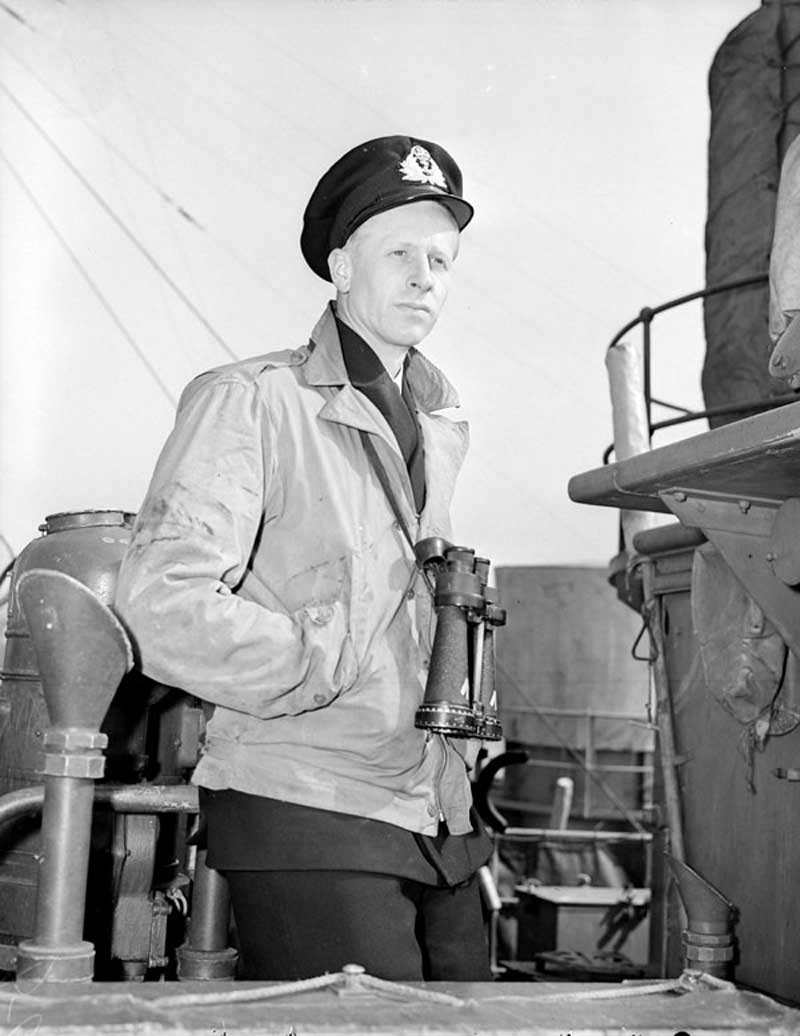
Lieutenant (N) Edward Theodore (Ted) Simmons of the Royal Canadian Naval Volunteer Reserve and Commanding Officer of HMCS Port Arthur, which sank the Italian submarine Tritone on Jan. 19, 1943. [Mikan 3526669]
The Royal Canadian Navy took a different tack, choosing to name its corvettes, including the Flower-class variety, after towns and cities, symbolically linking Canadians across the country to the war effort.
Communities took active interest in “their” sailors, sending them goods to make their life at sea more comfortable: knitted mittens and sweaters, goodies such as cookies and tinned goods, books and magazines.
“Those people must have had the biggest hearts in the world,” Port Arthur’s Chief Engine Room Artificer Leslie McLean told Mac Johnson for his book Corvettes Canada. “They nearly killed us with kindness before we left, and in the months after when there was always a large container of goodies for the ship’s crew.”
The citizens of Port Arthur, Ont., (now part of Thunder Bay) even offered $1,000 in prize money if the ship named for their town destroyed a Nazi U-boat.
In January 1943, the sailors of HMCS Port Arthur under Lieutenant (N) Ted Simmons were reminded of that prize when they witnessed HMCS Ville de Quebec ram and sink U-224 while one escort.
With barely a chance to spend their prize money, another submarine appeared on Jan. 19.
The doughty corvette was built in its namesake and commissioned in May 1942. It joined its first convoy in late August and by the end of the war it had escorted 40 Atlantic crossings.
Originally assigned to the Western Local Escort Force, by November the ship was escorting convoys to and from Gibraltar at the Atlantic entrance to the Mediterranean Sea, in preparation for the Allied invasion of North Africa.
With barely a chance to spend their prize money, another submarine appeared on Jan. 19.

HMCS Port Arthur. [Wikipedia]
“It was a millpond sea and we picked up an ASDIC sub contact on the starboard side of the convoy, which was our escort station,” Sub-Lieutenant Ray Richardson recalled in Jean Portugal’s book We Were There: The Navy.
“We followed the echo to within 400 yards [365 metres] and the hydrophone picked up the sound of her propellers. It was definitely a sub.” In fact, it was the Flutto-class Italian submarine Tritone, under the command of Lieutenant-Commander Paolo Monechi.
“So we hoisted our black flag and dropped a shallow depth charge pattern. A few minutes later, we ran in again and dropped another pattern,” detailed Richardson.
“Suddenly a very large sub surfaced about a quarter of a mile [400 metres] away, so close to HMS Antelope, a Hunt Class destroyer and our escort leader, that her gunners could not depress their forward guns to fire at it.
“What ensued was one of the most remarkable demonstrations of seamanship that I have ever seen.”
The Italian submarine lost 25 crew and one civilian in the incident; 25 were rescued and became prisoners of war.
Antelope’s skipper Lieutenant-Commander Erroll Norman Sinclair put the helm hard over and ordered full speed ahead, putting the ship into a sharp turn.
“As the ship heeled over in the tight turn, the gun’s crew were able to bring the forward gun to bear and a direct hit on the conning tower was the result,” said Richardson. “We of course were firing our four-inch gun.”
After Tritone surfaced, Port Arthur prepared to ram it, “but we had to bear off to keep out of Antelope’s line of fire,” said Richardson. (It was later learned the sub had been having trouble with its diving gear).
The Italian submarine lost 25 crew and one civilian in the incident; 25 were rescued and became prisoners of war, including Monechi.
Simmons, was awarded the Distinguished Service Order for his “outstanding skill and judgment” during the encounter. Sailors Gerry Boyer and Donald McLean each earned a Distinguished Service Medal for their roles, while anti-submarine control officer Sub-Lieutenant Peter Cowan received the Distinguished Service Cross.
Read more about Canada’s Second World War Flower-class corvettes in “The namesake navy.”
Advertisement





















